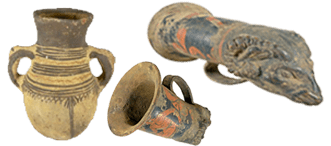Few things are more exciting than adding special pieces to a collection. Whether you collect artifacts, ancient coins, fossils, minerals, crystals or other antiquities from around the world, Ancient Artifacts & Treasures, Inc. has the inventory selection for you.

Amber in Nature
Ancient Artifacts & Treasures, Inc.
Amber is a form of tree resin — exuded as a protective mechanism against disease millions of years. Often regarded as a gem, amber is actually an organic substance whose structure has changed very little over time, unlike that of other fossilized material, in which organic matter is replaced with minerals.
Amber has preserved ancient life to such infinitesimal detail that it even captures fragments of DNA of the organisms entrapped in it. Such a wide variety of creatures has been found in Dominican amber, for example, that scientists are able to reconstruct this ancient ecosystem with amazing intricacy.
Because amber oxidizes and degrades when exposed to oxygen, it is preserved only under special conditions. Thus it is almost always found in dense, wet sediments, such as clay and sand that formed at the bottom of an ancient lagoon or a river delta. While hundreds of amber deposits occur around the world, most of them contain only trace amounts of the substance; only about twenty deposits in the world contain amounts of amber large enough to be mined.
Among the dozens of major amber deposits scattered throughout the world, most are from the Tertiary period, which dates from 1.6 to 65 million years ago. The deposits vary in age, botanical origin, color, and composition, and occur on every continent except Antarctica. The largest piece of transparent amber in the world, which weighs 33.5 pounds, comes from northern Myanmar, and is 40 to 50 million years old. Sicilian amber — deposits of which are much smaller – is approximately 20 million years old. The largest North American deposit of Tertiary amber is in Arkansas.
Some of the oldest amber in the world is from the Cretaceous period, 65-95 million years old. This amber, is found in New Jersey, the Middle East, Japan and in Northern Russia—the largest deposit. This is the type of amber made famous in the movie Jurassic Park.
The world’s largest amber deposits come from the shores of the Baltic Sea, where 44 million year old amber has been harvested, traded, and crafted into decorative objects for at least 13,000 years. The 400-square-mile Samland Peninsula alone has produced ninety percent of all the amber in Europe. Until the mid-nineteenth century, pieces of Baltic amber were collected primarily from beaches. Since the 1850s, when engineers began dredging and mining operations, millions of pounds of Baltic amber have been mined.
Twenty-three- to thirty-million-year-old amber from the Dominican Republic is prized for the diversity of inclusions it contains. Dominican amber is mined chiefly to the north and east of Santiago, where landslides reveal veins of lignite — or blackened, fossilized wood — which accompany amber deposits. Using shovels and machetes, the amber miners may burrow deep into mountains, sometimes forming tunnels 100 to 200 feet long. Slightly softer than Baltic amber, amber from the Dominican Republic was produced by a Hymenaea tree, a now-extinct tree of the legume family. Dominican amber occurs in several colors, including yellow and deep red, as well as the rarer blue and smoky green.

Amber with insects is rather scarce. Only one piece in one hundred of the Baltic amber has an insect inclusion. Dominican amber fossils are slightly less scarce with approximately one in ten having insect inclusions.



Comments are closed.